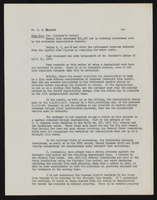Search the Special Collections and Archives Portal
Search Results
George Knox Roth Collection
Identifier
Abstract
The George Knox Roth Collection (1959-1980) consists of newspaper clippings (including photocopies), magazine articles, newsletters, technical reports and publications, correspondence, notes, and photographs relating to the Atomic Energy Commission, the environmental impact of nuclear testing in Nevada, Nevada mining, Airwest and the Hughes Airport, and other aspects of Howard Hughes’ Nevada operations. The George Knox Roth Collection also includes correspondence and expense reports related to his own company, General Research Consultants.
Archival Collection
Bob McCaffery Collection on the Save the Hughes Flying Boat Campaign
Identifier
Abstract
The Bob McCaffery Collection on the Save the Hughes Flying Boat Campaign (1980-1983) documents efforts by activists to preserve the plane from destruction and its subsequent acquisition by the Aero Club of Southern California in 1980. The collection contains photographs and newspaper clippings about the Hughes H-4 Hercules flying boat nicknamed the "Spruce Goose" from the 1980s.
Archival Collection
William Hillman Shockley Photograph Collection
Identifier
Abstract
The William Hillman Shockley Photograph Collection (1875-1925, 1951) contains black-and-white photographs documenting mining operations at the Mount Diablo Mine and Millworks in Candelaria, Nevada. It also includes photographs of nearby operations including the Northern Belle Mine and the Princess Mill. The collection contains photographs of Shockley, his son, William Bradford Shockley, as an infant, as well as images of Shockley’s brothers, Walter A. Shockley and George Shockley.
Archival Collection
Grace Hayes Photograph Collection
Identifier
Abstract
The Grace Hayes Photograph Collection consists of black-and-white photographic prints and negatives from approximately 1890 to 1980. The collection includes personal photographs of Hayes and her son Peter Lind Hayes and publicity photographs from Hayes's entertainment career.
Archival Collection
Tonopah, Nevada Mining Town Photograph Album
Identifier
Abstract
The Tonopah, Nevada Mining Town Photograph Album (approximately 1908) consists of twenty-two photographs in a leather-bound album. The photographs depict businesses, townspeople, street scenes, and mining operations in Tonopah, Nevada and the surrounding areas of Goldfield, Nevada and Mina, Nevada. Also included are photographs of a fire on May 12, 1908 that destroyed a block of commercial buildings in Tonopah, which were taken by local photographer E. W. Smith., and views of the downtown area both before and after the fire.
Archival Collection
University of Nevada, Las Vegas Arboretum Project Records
Identifier
Abstract
The University of Nevada, Las Vegas Arboretum Project Records are comprised of documents, brochures, and photographs dating from 1976 to 2012 documenting both the creation and operations of the Arboretum at the University of Nevada, Las Vegas (UNLV). The collection includes photographs of planning the Arboretum, the opening ceremony, and aerial photos of the UNLV campus. The brochures include guides to the Arboretum, lists of types of plants grown, and information on the Xeric Garden.
Archival Collection
Sadie and Hampton George Papers
Identifier
Abstract
The Sadie and Hampton George Papers (1874-1948) consist primarily of the incoming and outgoing correspondence of Sadie Kiel George and her husband, Hampton George, regarding proposed land and mineral rights sales. The collection also includes some personal correspondence, and two of the most significant letters in the collection deal with the deaths of brothers William and Edward Kiel, Sadie's uncles, who were found dead at the Kiel Ranch in October 1900. Also included in the collection are receipts, cancelled checks, tax notices, mining claims, and land deeds.
Archival Collection

Interview with Louis Francis Wouters, May 20, 2004
Date
Archival Collection
Description
Text

Transcript of interview with Edward "Ed" Butera by Stefani Evans and Claytee White, July 28, 2016
Date
Archival Collection
Description
Engineer Edward "Ed" Butera spent hours constructing models from the time he was a five-year-old boy in San Jose, California. Besides his interest in building and design, the young Butera also loved math and music—specifically the clarinet, at which he excelled, and which he still enjoys. After earning his Bachelor’s degree in Electrical Engineering at San Jose State University he was hired by Ralph Joeckel as a consulting engineer for Trane, a heating and air conditioning company. Joeckel became a mentor and "second dad" to Butera after the company sent him to Las Vegas in 1972, and the two remain close to this day. In this interview, Butera shares how he engineered and designed power, water, sanitation, utilities, and heating and cooling systems on many Clark County high schools, hospitals, and data centers while considering such factors as the building's shape and its affect on the way wind forces act on its glass, windows, and doors. He talks of his casino work that began with the Stardust soon after he arrived in Las Vegas, and before his client list grew to include Tony Marnell, Steve Wynn, and MGM. Besides the hotels, he shares his experiences engineering the infrastructure for the Bellagio fountains, The Mirage volcano, Treasure Island's pirate show.
Text

